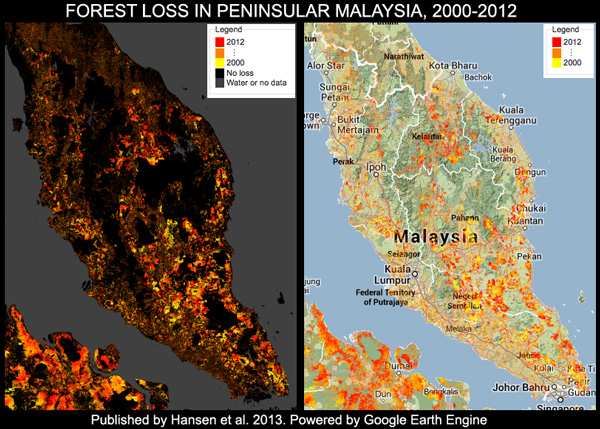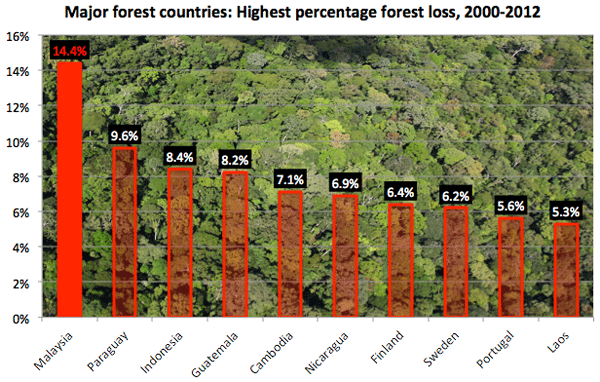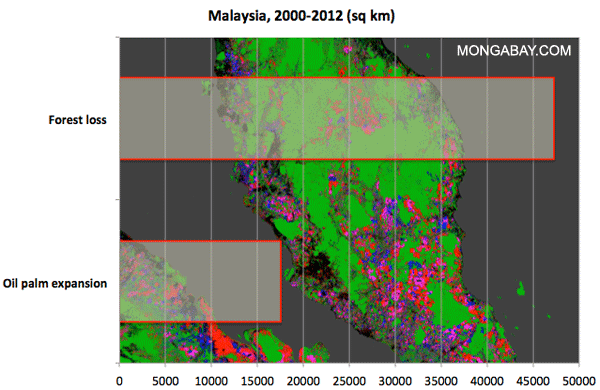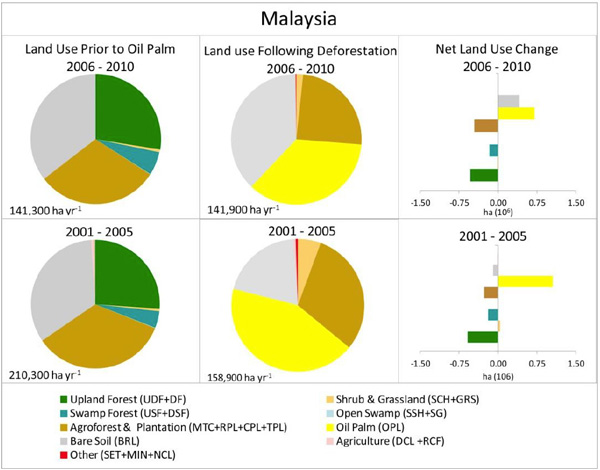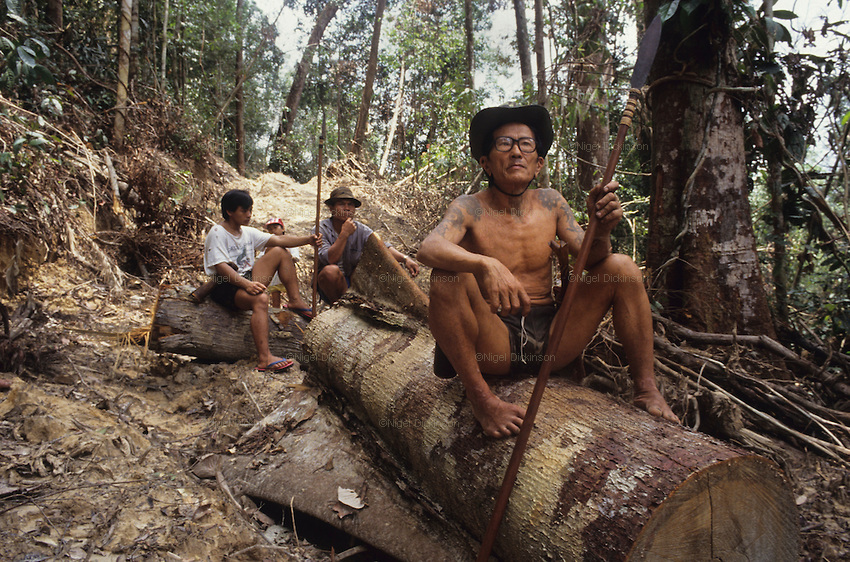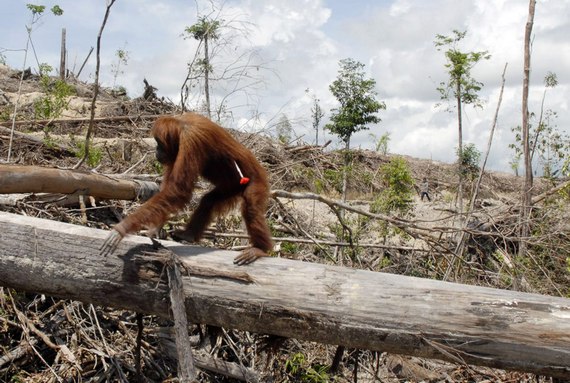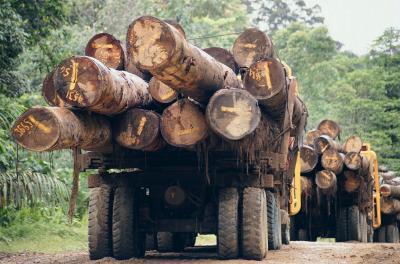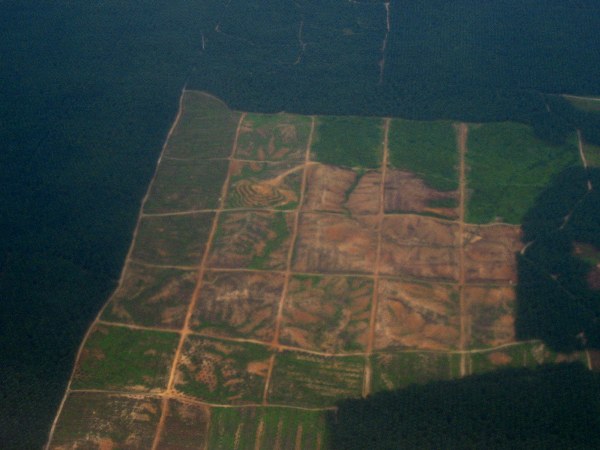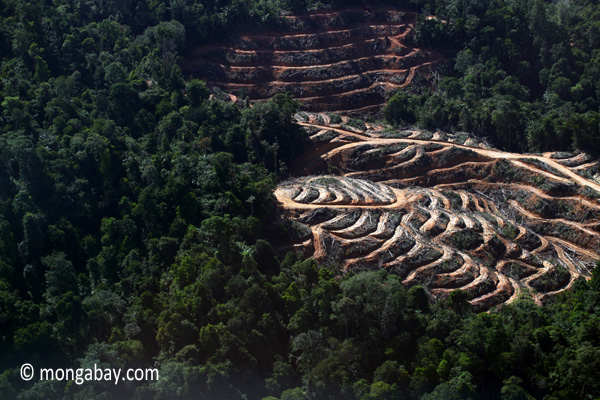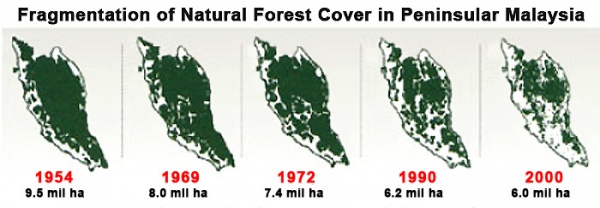No Other Country Is Losing Their Forests Like Malaysia. These Maps Will Shock You.
As our palm oil plantations grow, the trees in our natural forests die.
Malaysia's Rainforest Has The World's Highest Deforestation Rate Between 2000-2012
Forest loss in Peninsular Malaysia. Some of Malaysia's forest loss included replanting of existing plantations — the current version of the map does not distinguish between natural forest cover and plantations.
Image via amazonaws.comMalaysia had the world's highest rate of forest loss between 2000 and 2012, according to a new global forest map developed in partnership with Google.
mongabay.comThe map for Malaysia's deforestation shows that the most intense clearing activities took place in the states of Kelantan, Terengganu, Pahang and Johor, while there are also many red areas appearing in the long coastal areas from Sibu to Miri in Sarawak.
In Only 12 Years, The Area Of The Forest Lost In Malaysia Is Larger Than The Surface Area Of Denmark
Malaysia's Rainforest Has The World's Highest Deforestation Rate Between 2000-2012
Image via amazonaws.comMalaysia's total forest loss during the period amounted to 14.4 percent of its year 2000 forest cover. The loss translates to 47,278 square kilometers (18,244 square miles), an area larger than Denmark.
mongabay.comThe findings of the mapping - which documents forest loss and gain between 2000 and 2012 based 650,000 satellite images - was carried out by a team from University of Maryland and was published in a science journal, reported international broadcaster BBC.
During The Same Period, Malaysia's Oil Palm Plantations Grew By Approximately 50%
During The Same Period, Malaysia's Oil Palm Plantations Grew By Approximately 50%
Image via amazonaws.comMalaysia's forest loss was partly offset by a 25,978 sq km gain in vegetation cover resulting from natural recovery, reforestation, and establishment of industrial timber and oil palm plantations. During the period, Malaysia's oil palm estate grew by roughly 50 percent or 17,000 sq km.
mongabay.comThis Was After Years Of Unsustainable Logging For Timber Stocks
Summary of land use change in Malaysia (bottom). Left column: land use prior to the establishment of new oil palm plantations (in the lower left corner is the total annual increase in oil palm plantations). Middle column: the fate of land following forest conversion (in the lower left corner is the annual rate of deforestation). Right column: net land use change over each five year period.
Image via amazonaws.comAfter decades of unsustainable logging, which depleted timber stocks and undermined the viability of traditional forestry management, Malaysia's forests are increasingly being converted for industrial oil palm plantations. The palm oil industry is a powerful political force in the country.
mongabay.comThe Deforestation Rate In Malaysia Is A Stagerring 50% Higher Than The Next Runner Up, Paraguay
Malaysia's rate of forest loss during the period was nearly 50 percent higher than the next runner up, Paraguay (9.6 percent). Its area of forest loss ranked ninth after Russia, Brazil, the United States, Canada, Indonesia, China, the Democratic Republic of Congo, and Australia. Malaysia's net forest loss — 21,480 sq km — ranked 12th globally.
charity-charities.orgThese Were The Same Dense Forests That Housed Endangered Native Species Such As Orangutan, Rhinoceros, Elephants And More
The same source tells us that over 50% of the forests Malaysia lost in little over a decade were dense ones that not only housed endangered species such as orangutans, pygmy elephants, Sumatran rhinos, and clouded leopards, but were also quite effective at trapping carbon and storing it.
While Some Forests Have Been Replanted Over The Years, The New Trees Are No Where As Dense Nor Valuable As They Were
Dan Zarin, program director of the Climate and Land Use Alliance, an association of philanthropic foundations, says trading natural forests for planted forests represents a net loss for the planet. “You can't ‘net out’ deforestation by planting trees," said Zarin, "because newly planted forests are far less valuable for carbon, biodiversity and forest-dependent people than standing native forests.”
charity-charities.orgOffsetting the loss in forests was a 25,978 sq km gain in vegetation cover resulting from natural recovery, reforestation and establishment of industrial timber and oil palm plantations. The report noted that the oil palm industry was a powerful political force in the country.
According to WWF, Malaysia's forests cover 59.5% of the land area
Malaysia's land surface was once almost entirely covered with forest. Today, forests still cover about 59.5% of the total land area. In the 20 years from 1983 to 2003, there was a reduction of about 4.9 million hectare of forest cover in Malaysia.
wwf.org.my